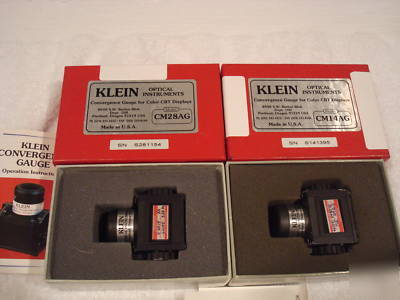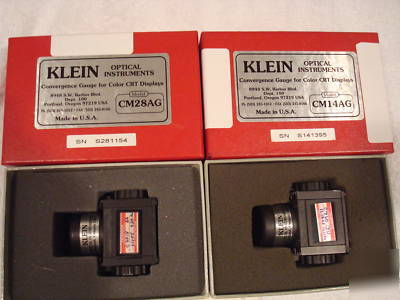Environmentally Conscious and Economically Sound Machine Dismantling Forum > Milwaukee
> Antiques
> Leather FLat Belt Eqiuptment
> 2 - klein - convergence gauges - optical instruments
2 - klein - convergence gauges - optical instruments
Convergence Gauge - Model numbers CM14AG & CM28AG
Both are used , both are in nice shape.
What you see in the pictures is what you will receive.
Retails for about $790.00 each
Additional information as follows...
It's probably the most convenient and reliable way to check display convergence on your color monitor. The Klein Gauge works on the principle of Optical Reconvergence of an image where the amount of reconvergence necessary is a measure of the convergence error present.
(fig. A) If a parallel prism is rotated to an angle 0 from its usual position, the image will be displaced a distance "d" depending on 0, the thickness "t", and the index of refraction of the prism "n'", as given by a formula derived from Snell's Law:
d = tcos0(tan0-tan(asin((sin0)/n')))
Within the Klein Gauge, there are three prisms, each which passes one of the phosphor colors of a CRT. The center prism is stationary and its image is used for position refrence. The two outer prisms rotate.
As an outer prism is rotated, the image beneath it appears to shift. The amount of shift is calibrated in millimeters on the gauge's scale. When the three colors of the image is shifted so that they are optically reconverged, the gauge scales read the convergence error present.
Note that the displacement distance "d" is independent of the prism-to-image distance "D"; thus, the gauge measurement is free from parallax error which depends on scale-to-image distance.
(fig. B) Generate a white grid pattern. Place the gauge against the screen on an area where convergence is to be measured. The orientation of the gauge shown is for measurement of convergence error in the "Y" direction. To measure the "X" direction, the gague is rotated 90 degrees.
(fig. C) If the horizontal lines of the grid pattern are misconverged, they will appear as three separate red, green, and blue lines. Rotate the knob on each side of the gauge until the brightness centers of the three images line up.
(fig. D) The image has now been optically reconverged, and the amount of convergence error between blue/green and red/green can be read from the scales. The red/blue error can be obtained by subtracting the two readings.
When it comes to precise measurement, you just can't afford to be wrong. But, unless you have the right tools, your measurements are only guesswork.
Getting it right is easy with the Klein Convergence Gauge. It's the only affordable, hand-held equiptment around that can check display convergence on color monitors. Extremely accurate, the CM7AG has a full scale reading of 0.7 mm, and divisions are marked to .05 mm.
That means not only can you provide claims and verify specifications, but you'll be able to do the job faster and with virtually no eyestrain.
So whether you're in advanced computer technology, avionics displays, or any other job that requires CRT screen accuracy, get the Klein Convergence Gauge. And, there's a very good chance you'll never be wrong again.
* Base dimensions 1.5" x 2.4" (38mm x 60 mm), weight 6 oz (170 grams)
* Adjustable pointer for true zero adjust
* Rugged construction, aluminum alloy body, & black anodized finish.
* All listed models are only $790.00 US-Dollars!
The following versions of this gauge are available for every application:
Model Scale Range Scale mm/div Center Prism CM7AG 0.7 mm 0.05 mm Green
CM7AR 0.7 mm 0.05 mm Red
CM14AG 1.4 mm 0.10 mm Green
CM14AR 1.4 mm 0.10 mm Red
CM28AG 2.8 mm 0.20 mm Green
CM28AR 2.8 mm 0.20 mm Red

